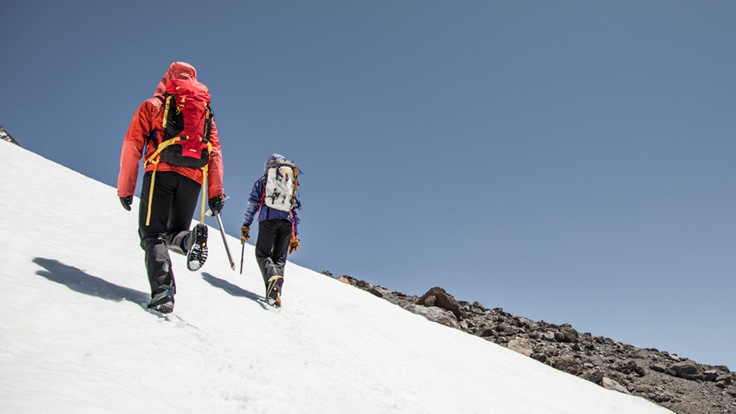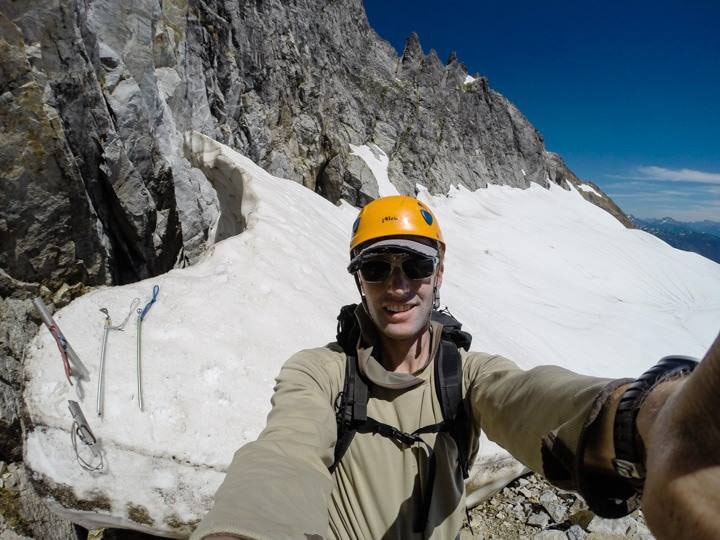There comes a time in some backpackers' lives when they look up at the summit of a snowy peak and wonder what it would take to get there. If you've found yourself dreaming up loftier goals, then perhaps it's time to try mountaineering.
What is mountaineering? In some ways, climbing a mountain is not all that different than backpacking. You often start out on an established trail with a pack on your back that's loaded with gear and supplies you'll need for the duration for the trip. But, where the goal of backpacking is to complete a scenic loop or hike out and back while camping along the way, the purpose of mountaineering is to stand on the summit of a peak, and you often get there by traveling on snow, and possibly even glaciers or ice.
What does mountaineering entail? Mountaineering can be very physically and mentally demanding, with long hours spent working your way slowly up and down a mountain with a heavy pack on your back. And before you can go, you'll need to know technical skills, such as how to use an ice axe and how to rescue a climber from a crevasse. But the reward of reaching the summit and the sense of accomplishment you'll have upon completing the journey can make it all worthwhile.
If mountaineering sounds like something you want to try, here's how to get started:
- Hire a guide or take a class: A qualified guide will lead the way and teach you essential skills for climbing a mountain. If you want to go without a guide, first sign up for a class (or several) to learn how to travel on snow and glaciers, how to use an ice axe and how to rescue a fallen climber from a crevasse.
- Start training: Mountaineering is physically and mentally demanding. Start doing hikes with a weighted pack on and get yourself mentally ready for long, challenging days.
- Acquire essential gear: Mountaineering boots, an ice axe, crampons and a harness are a few of the items you'll need. You may be able to rent some of these things, or if you're going with a guide service, they may be provided.
- Choose a route: Whether you're signing up for guided climb or picking a peak to ascend with your own climbing team, it's important to choose a route that's right for your skill and comfort levels.
Climbing safety is your responsibility. No article or video can replace qualified instruction and experience.
Step One: Hire a Mountaineering Guide or Take a Class
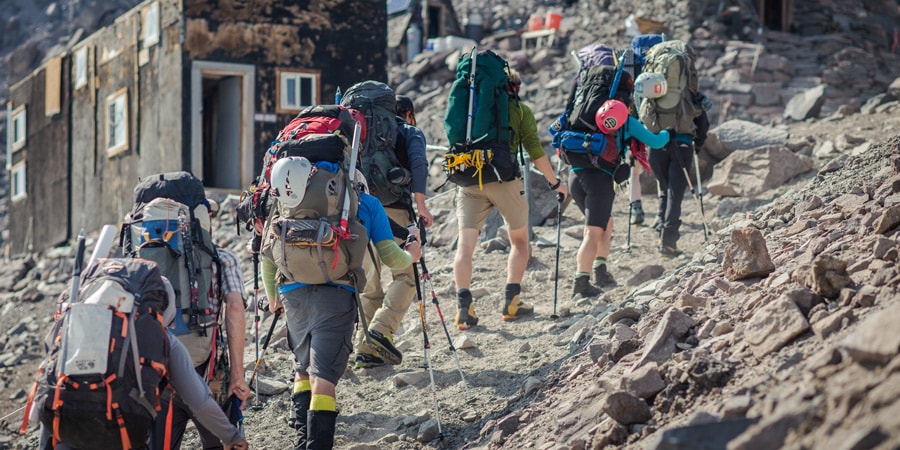
If you're new to mountaineering, one way to jump right into the sport is to hire a guide service. If you are reasonably fit, there are countless mountain guides worldwide who will take you up just about any mountain you wish. Qualified guides are skilled at introducing beginners to mountain climbing and know how to explain and demonstrate techniques that are easy to understand and tailored to your needs.
To find a guide service, look for local climbing organizations or private guide services in the area where you want to explore. We recommend finding a guide that's recognized by a certifying body, such as the American Mountain Guides Association.
Take a Mountaineering Class
Not everyone who goes mountaineering hires a guide. Mountaineering on your own can give you not only the thrill of the alpine experience, but a deep sense of accomplishment as well. But, before you attempt your own climb, you first need to master technical skills and acquire a sense for how to travel in the mountains. While it's possible to learn from an experienced mentor or friend, we recommend signing up for classes taught by trained professionals. There are many organizations, schools and clubs that provide this training; some offer months-long courses that will teach you what you need to know and culminate in a climb that utilizes your newfound skills. It's also possible to piece together several shorter classes to learn the essentials.
Here are some of the skills you need to have before you go mountaineering:
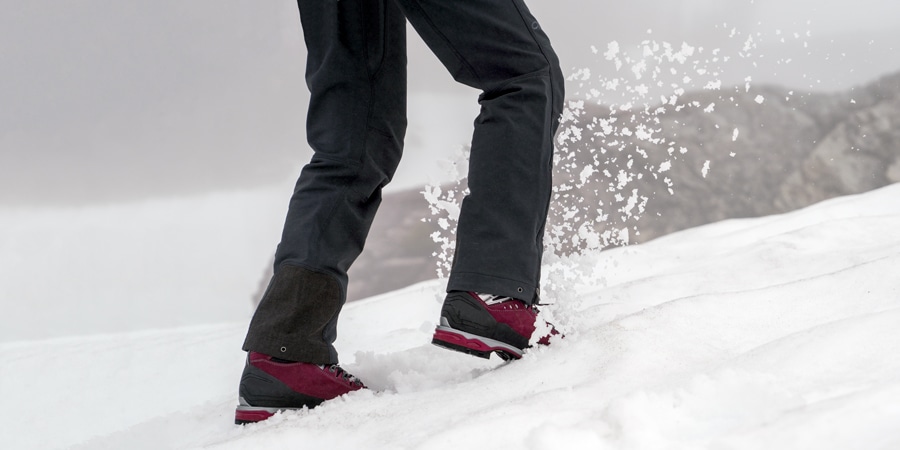
Snow travel techniques: Knowing how to safely and efficiently travel on snow starts with good footwork. Step-kicking, plunge stepping and glissading are all effective ways to ascend and descend snowy slopes. Learn more in our Snow Travel Techniques article.
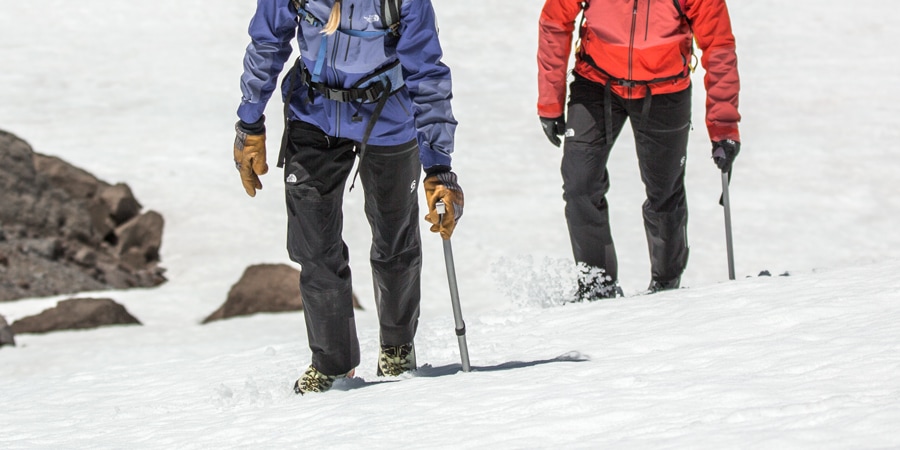
Using an ice axe: Ice axe use is one of the fundamentals you need to learn for mountaineering. Self-belay involves planting the shaft of the axe into the snow to guard against falling in the first place. If you should slip and fall, the self-arrest is used to stop you before you slide too far. Proper instruction and practice are necessary to become proficient at both of these ice axe techniques. Learn more about using an ice axe.
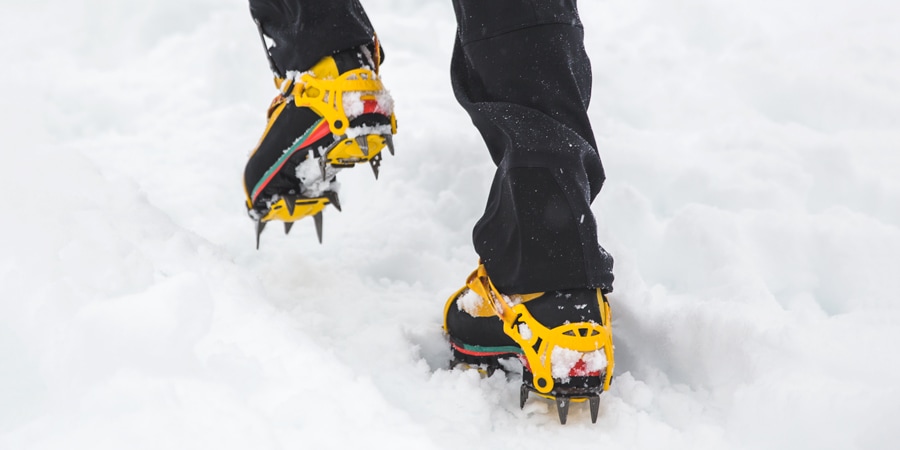
Using crampons: Crampons provide essential traction on icy terrain that you otherwise wouldn't be able to ascend. It's important to know how and when to put crampons on and when to take them off. Practice is required to become comfortable walking with crampons on your boots. Learn more about crampons in our article, How to Use Crampons.
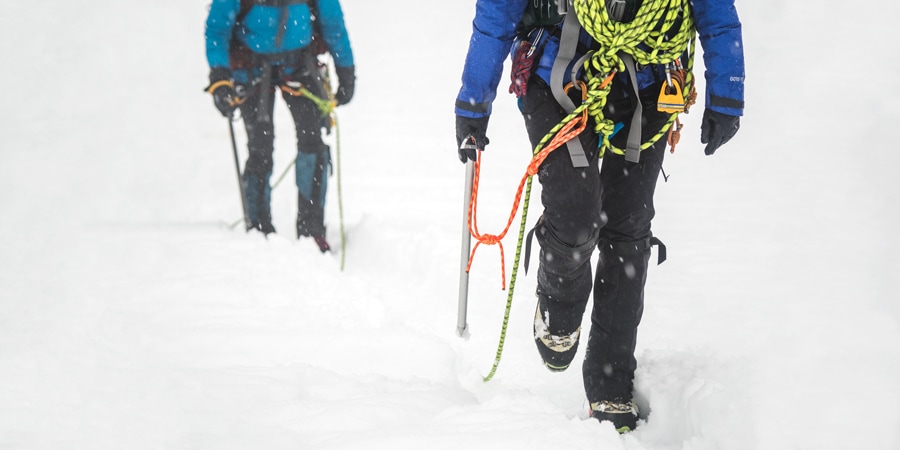
Roped glacier travel: Using an axe becomes even more important when you are roped to one or more people while crossing a glacier. Not only do you need the skills to stop your own fall, but you need to be alert to the others on your rope team and be ready to self-arrest should one of them slip and start heading for a crevasse or a drop-off. Rope management is equally important. Knowing when and how to rope up, how much slack to leave and how to belay other climbers is a set of skills best taught by experienced mountaineering schools or clubs. Learn more about roped glacier travel.
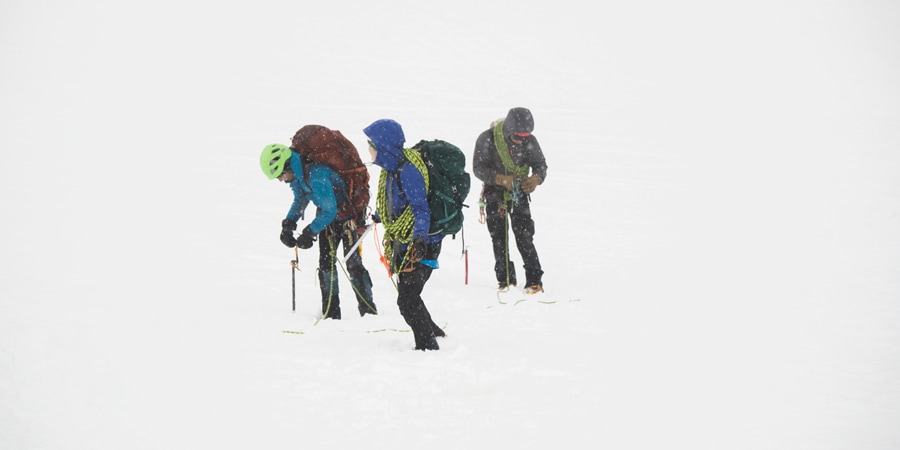
Navigating crevasses and whiteouts: For much of the spring and summer, basic snow routes on mountains in the United States are straightforward roped ascents. In late summer or fall, though, crevasses begin to open up as the year's snowfall melts away. Previously smooth, packed glaciers can become a puzzle of jumbled ice and a maze of cracks. Route finding can be much more challenging in these conditions. Whiteouts, too, offer their own special "charm." Skill with an altimeter and a compass is imperative for mountaineering.
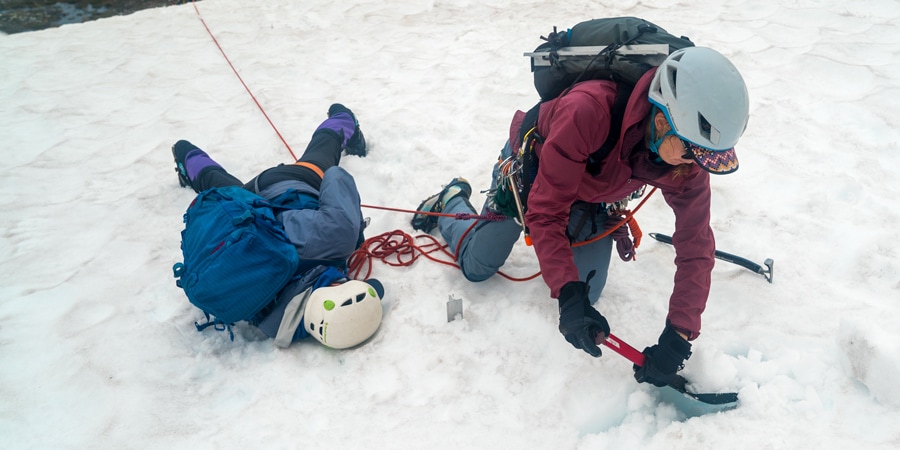
Crevasse rescue: And one last thing to ponder before striking out on your own: Would you be able to rescue a companion from a crevasse if he or she were to fall in? Proper use of snow anchors, and a system known as the Z-pulley is an essential set of skills for safe glacier travel. Even experienced mountaineers practice these and other rescue techniques each season to prepare for the unexpected. Learn more about crevasse rescue.
Step Two: Start Training for Mountaineering
The joy of standing atop a summit, gazing out as the landscape unfolds below your feet, doesn't always come easy. Mountaineering presents many physical and mental challenges; it's common to spend 12-14 hours a day inching your way uphill with a heavy pack on your back. To prepare yourself for these challenges, it's necessary to be physically and mentally prepared.
Physical Preparation
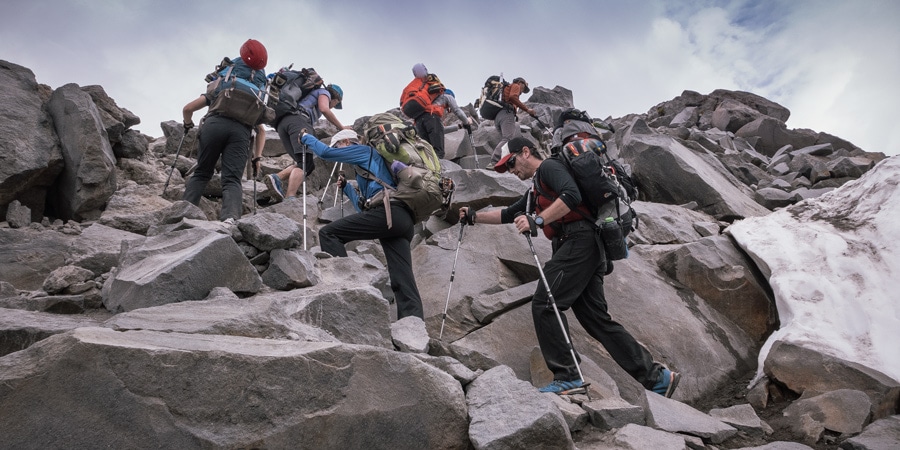
The seemingly simple act of putting one foot in front of the other can be utterly exhausting when you're hauling a heavy pack and you've already been moving for hours.
To be ready for the strenuous challenges of mountaineering, most people need to begin frequent and consistent training several months prior to a trip. A regular training routine that involves running, cycling and swimming is a good way to prepare your cardiovascular system. Indoor stair climbers can help to build leg muscles used for climbing. Weight lifting can strengthen the upper body for carrying a pack.
The best training for climbing with a pack, though, is to climb with a pack. Put some weight on your back and head uphill. Try nearby hikes where you can gain elevation. Or find a long set of stairs and do some repetitions. This type of training will improve your stamina on a long approach more so than running or cycling.
While being physically ready for long days of hiking uphill with a heavy pack is important, the effects of high altitude as you ascend a mountain can be unpredictable. At altitudes above 8,000 feet (and occasionally as low as 5,000 feet), even the most physically fit people can start to feel the effects of decreased oxygen in the atmosphere. Signs of moderate altitude illness are difficulty sleeping, irregular breathing during sleep, headache, weakness, fatigue, nausea, dizziness and shortness of breath. To learn more about altitude sickness and what you can do to prevent it, read our article, How to Identify and Treat Altitude Sickness.
To learn more about physical preparation for mountaineering and to see a sample workout routine, read our article, How to Train for Mountaineering.
Mental Preparation
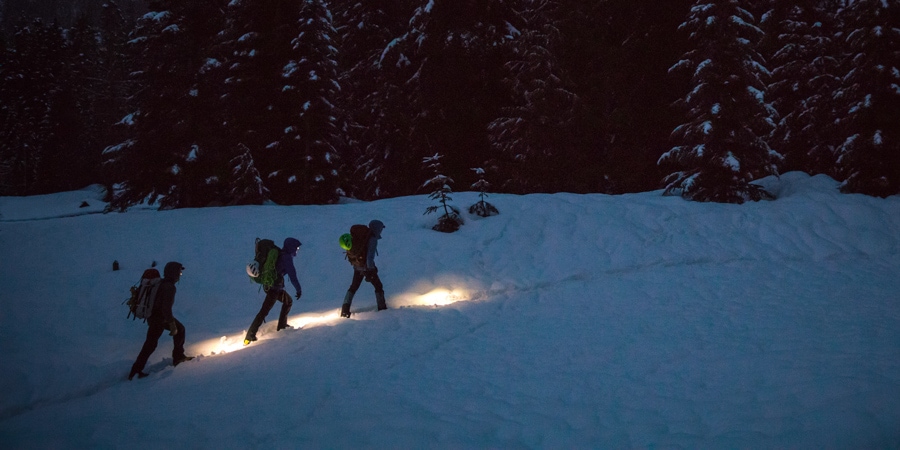
Mountaineering requires more than athleticism and technical climbing skill. It takes a different mindset from sport climbing close to civilization or backpacking on an established trail. You must commit more time and energy to complete a mountaineering climb, and you must be prepared for some hardships, discomfort and possible dangers along the way, such as falling rock, falling ice, avalanches and falls into crevasses. There's also the disappointment that fickle mountain weather can bring; no matter how hard you've trained, prepared and prayed for sun, a storm can force you to turn back before reaching the summit. For these reasons, mountaineering is not for everyone.
The rewards of going into the mountain environment can be tremendous, though. Picture a star-filled sky, crampons crunching underfoot and the sound of your steady breathing. Headlamps dot the route upward, then go out one by one as the first fingers of light paint the glacier pink and you reach a view that many people only see from an airplane. These are the moments that draw people away from the comfort of a rock gym or the certainty of a short climb close to the road.
Step Three: Get Essential Gear for Mountaineering
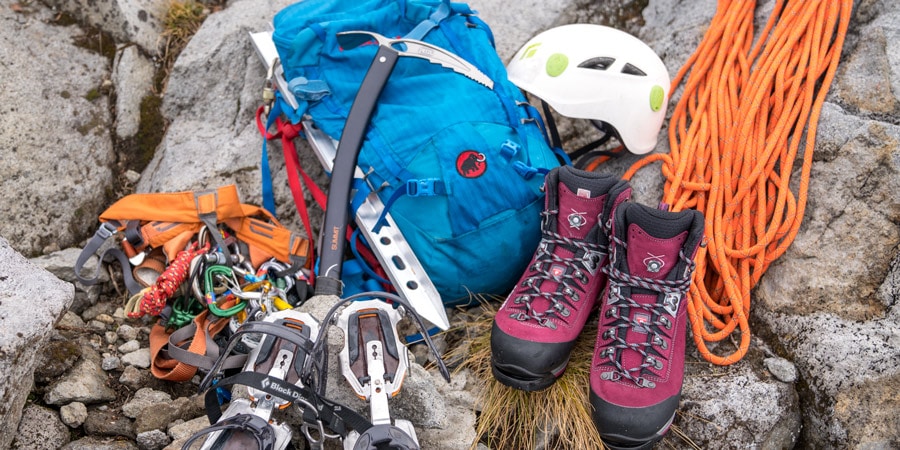
Mountaineering is a gear-intensive activity. If you're hiring a guide service, some gear may be provided or available to rent, so check with them before purchasing. Exactly what you need to take along varies depending on the route you plan to climb, but here are some of the personal items you'll likely need:
- Mountaineering boots: A comfortable, sturdy pair of crampon-compatible mountaineering boots are key to efficient travel in the mountains. Mountaineering boots are stiffer than backpacking boots, which makes them more supportive when you're walking with crampons on.
- Climbing harness: A standard rock-climbing harness can be used, but one that's designed specifically for mountaineering will be lighter and more comfortable.
- Ice axe: A single ice axe designed for general mountaineering is what you'll need most of the time for ascending steep slopes and self-arresting if you slip. More technical routes may require two ice tools.
- Crampons: Steel or aluminum crampons provide traction when you're walking on steep snow or ice. Aluminum crampons are very light, but not nearly as durable as steel, so only choose them if you'll be sticking to moderate snowfields without any sections of rock.
- Climbing helmet: Any standard rock-climbing helmet will work. Make sure it has clips for attaching a headlamp.
This is only just the beginning; a lot more gear may be required for your mountaineering trip. Learn more in our article, Mountaineering Gear Essentials, and use our Mountaineering Checklist before you leave home.
Step Four: Choose a Mountaineering Route
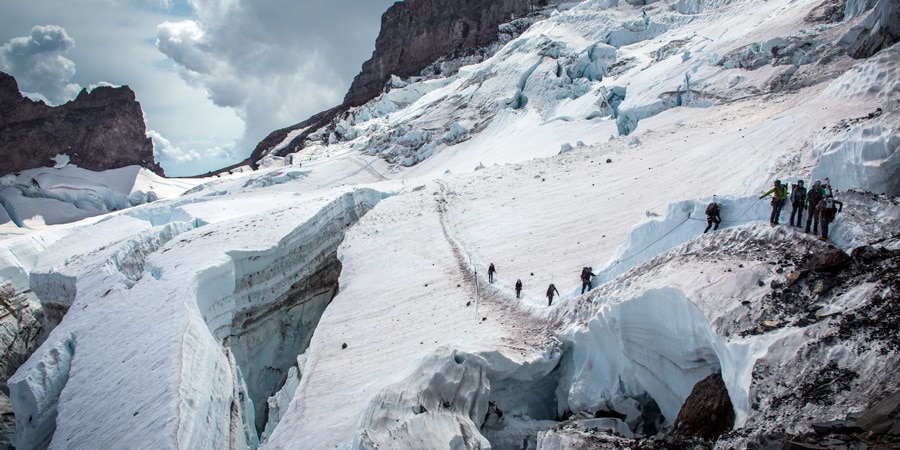
If you've decided to hire a guide to take you on a climb, talk to them about what your goals are and what kinds of climbs (if any) you've already done. They'll be able to help you determine a climb that's challenging but doable for you.
If you've completed a mountaineering course and are ready to do a climb unguided, you'll need to think about what skills you have and pick something that's well within your technical and physical abilities. Rather than picking the biggest peak around for your first outing, it's wise to gain experience on smaller, less-technical mountains first.
Tips for Choosing a Mountaineering Route:
- Consult guidebooks and websites: Books and websites are great resources because you can see all the info you're likely to need: difficulty, distance, elevation gain, directions, water sources, trail features and more. Websites may also showcase recent trip reports that may give you a great sense of what the trip will really be like at the time you plan to go. Online sites like SummitPost.org are great options.
- Talk to locals and other mountaineers: Talking to people familiar with the area or other folks who mountaineer can be a good way to get route suggestions. Also, try contacting local ranger districts in the area where you want to travel. Rangers will have the most up-to-date information about conditions.
- Know the type of climbing required: Does the route require snow travel, glacier crossings or rock scrambling? It's essential to know what type of climbing is required so you can decide if you have the necessary skills. You can generally find this information in guidebooks or in online route descriptions.
- Research permits: Mountaineering is an increasingly popular sport, and as the mountains become more crowded more areas are requiring user permits to limit traffic and resulting human impact. Many of the more frequently climbed mountains require some advance planning to allow for permits and registration. Be sure to contact the appropriate agency or land manager before climbing.
- Know how long the climb will take: Some routes can be done in a day while others take weeks. Consider how much time you have and pick a climb that fits. It's always wise to build extra time into your schedule in case you're moving slower than planned.
Learn more about planning a mountaineering trip.
Related Articles
Mountaineering Gear Essentials
